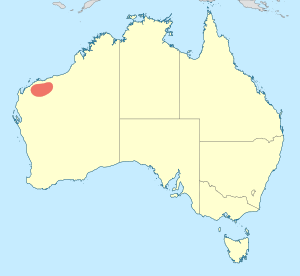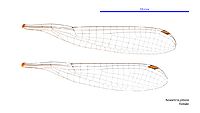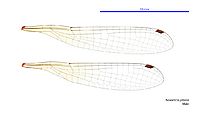Nososticta pilbara facts for kids
Quick facts for kids Pilbara threadtail |
|
|---|---|
| Conservation status | |
| Scientific classification | |
 |
The Pilbara threadtail (scientific name: Nososticta pilbara) is a special type of damselfly found only in Australia. It belongs to the family Platycnemididae. This small insect gets its name from the Pilbara region in Western Australia, which is the only place it has ever been found.
Pilbara threadtails live near streams and pools. They are quite slender and small. Their bodies are mostly black, but they have bright orange markings that make them stand out.
Contents
What is a Damselfly?
Damselflies are amazing insects that look a lot like dragonflies. They are part of a group called Odonata. Both damselflies and dragonflies have two pairs of strong, clear wings. They also have large eyes that help them see very well.
However, there are a few ways to tell them apart. When a damselfly rests, it usually holds its wings together over its back. Dragonflies, on the other hand, often hold their wings out to the sides. Damselflies also tend to be more slender than dragonflies.
Where the Pilbara Threadtail Lives
The Pilbara threadtail is unique because it lives only in the Pilbara region of Western Australia. This area is known for its hot, dry climate and ancient landscapes. Despite the heat, there are many rivers and creeks.
These damselflies need fresh water to survive. They are often found near slow-moving streams, rocky pools, and other wet areas. These watery spots provide a home for their young, which live in the water.
What the Pilbara Threadtail Looks Like
The Pilbara threadtail is a small and delicate insect. It has a long, thin body, which is typical for damselflies. Its main body color is black.
However, it has bright orange patterns on its body. These orange markings can be found on its head, chest, and parts of its abdomen. These colors help it blend in or stand out, depending on its surroundings.
Wings of the Pilbara Threadtail
Like all damselflies, the Pilbara threadtail has two pairs of wings. These wings are clear and have a network of tiny veins. The wings are very important for flight. They allow the damselfly to dart quickly through the air.
The male and female Pilbara threadtails have slightly different wing patterns. Scientists study these differences to learn more about the species.
Life Cycle of a Damselfly
The life cycle of a damselfly, including the Pilbara threadtail, is fascinating. It has three main stages: egg, nymph, and adult.
Eggs and Nymphs
Adult female damselflies lay their eggs in or near water. They often place them on underwater plants. Once the eggs hatch, tiny creatures called nymphs emerge.
Damselfly nymphs live entirely underwater. They are skilled hunters, feeding on small aquatic insects and other tiny creatures. Nymphs breathe using special gills. They grow by shedding their skin several times, a process called molting. This stage can last for months or even years.
Adult Damselflies
When a nymph is ready to become an adult, it crawls out of the water. It usually climbs onto a plant stem or a rock. Then, its skin splits open, and the adult damselfly emerges. This is a truly amazing transformation!
The adult damselfly then flies off. Its main job is to find a mate and lay eggs, starting the cycle all over again. Adult damselflies are also hunters, catching small flying insects like mosquitoes and flies.
Why the Pilbara Threadtail is Special
The Pilbara threadtail is listed as an Endangered species by the IUCN (International Union for Conservation of Nature). This means it faces a very high risk of disappearing from the wild.
Its endangered status is mainly because it lives in such a small area. If its habitat is damaged, it has nowhere else to go. Protecting the streams and pools in the Pilbara region is very important for the survival of this unique damselfly.
Gallery




